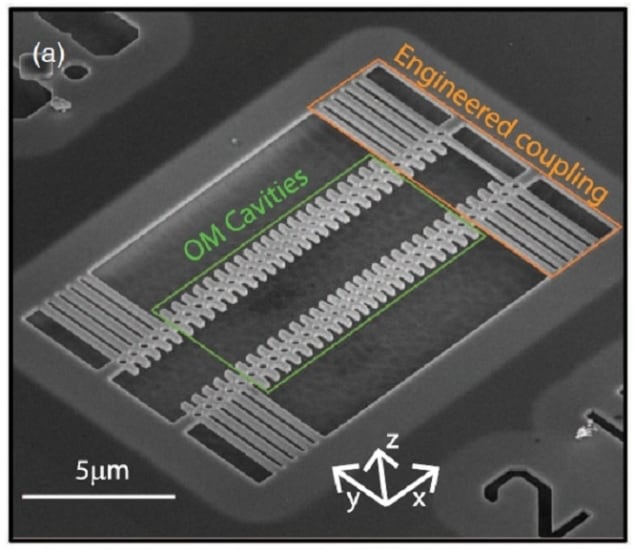
From the Huygens pendulum clocks in the seventeenth century onwards, the synchronization of coupled oscillators has had numerous practical uses. While most of these applications have been in mechanical and electrical engineering, nowadays there is increasing focus on applications in biology and neuroscience. With the development of nanotechnologies, scientists’ efforts have centred on synchronizing oscillatory nanoelectromechanical systems (NEMS), for applications such as on-chip time keeping, and mass, gas, and force sensors.
Martín Colombano and Guillermo Arregui from the ICN2 Phononic and Photonic Nanostructures Group in Barcelona and Universitat Autònoma de Barcelona, alongside colleagues in Spain and Italy, achieved spontaneous synchronization of coherent mechanical motion of a pair of one-dimensional silicon optomechanical cavities (OMC) integrated in the same chip, by a weak interaction between the two mechanically linked cavities. The results pave the way towards synchronizing arrays of nanoscale mechanical oscillators, building networks that may be useful in neuromorphic computing.
Self-sufficient yet sensitive
To enable spontaneous synchronization between two dynamical systems, they must firstly be self-sustained oscillators, that is, they must maintain the same rhythm, with no explicit time dependence, and their oscillation should be determined by the parameters of the system and stable to small perturbations. In addition a weak interaction should be able to adjust the rhythm of the oscillators within a certain range of mismatch of the systems. The experiment by Colombano, Arregui and colleagues is the first to fulfill these conditions for nanoscale OMCs.

Silicon resonators pass the Bell test for quantum entanglement
In the experiment, the researchers optically isolate the OMCs from each other, measure them independently, driving each one to a state of high amplitude, coherent, and self-sustained mechanical motion using the radiation pressure force exerted by two infrared lasers. They named the two cavities master and slave, where the cavity displaying the higher oscillation frequency and longer optical resonance wavelengths is the master and the other is the slave. The master oscillation amplitude is significantly larger, which tells us that its dynamics are much less sensitive to slave oscillations. Nonetheless, the master is mechanically excited by coherent motion of the slave through mechanical coupling of both OMCs.
The research also explores the effect of the top heating laser illuminating the master cavity. When this laser is switched on, the synchronized state is lost and the coupling is reduced. When the laser is switched off, it takes several microseconds for the OMCs to reach the synchronized state. This demonstrated dynamical switching between the two states by an external heating source.
Full details are reported in Physics Review Letters



